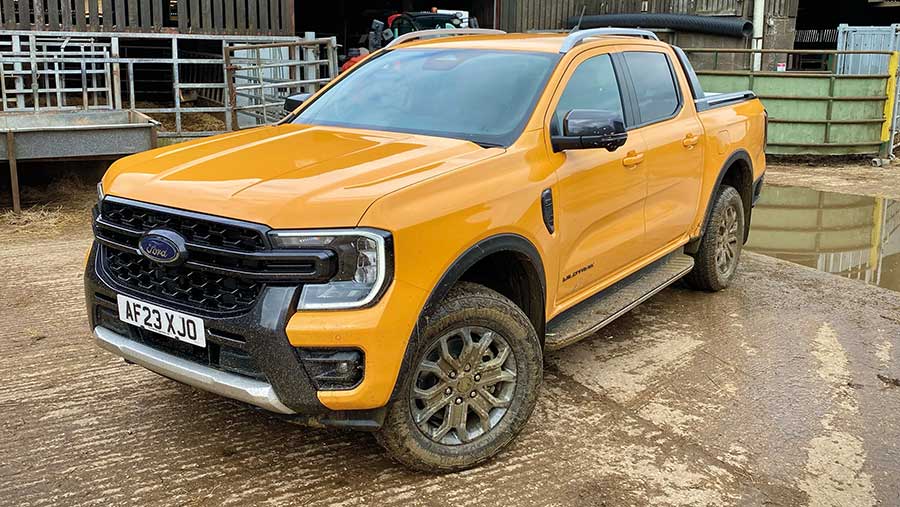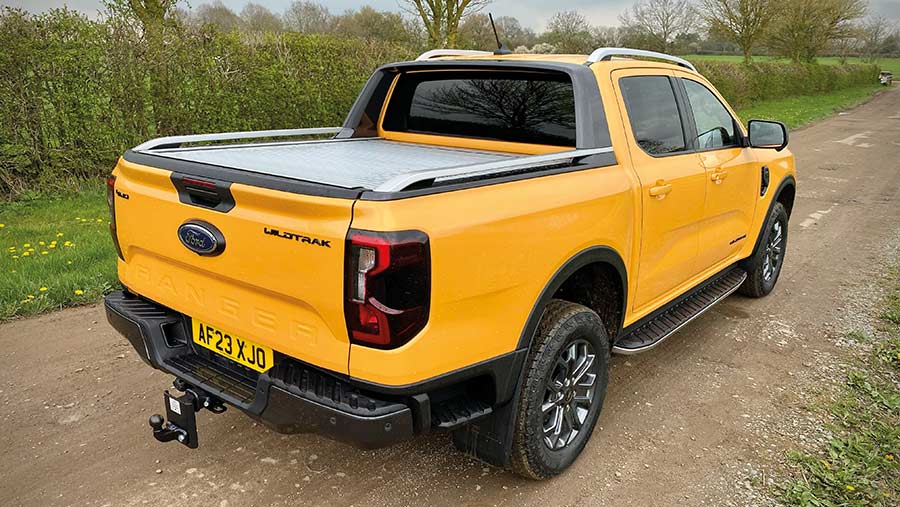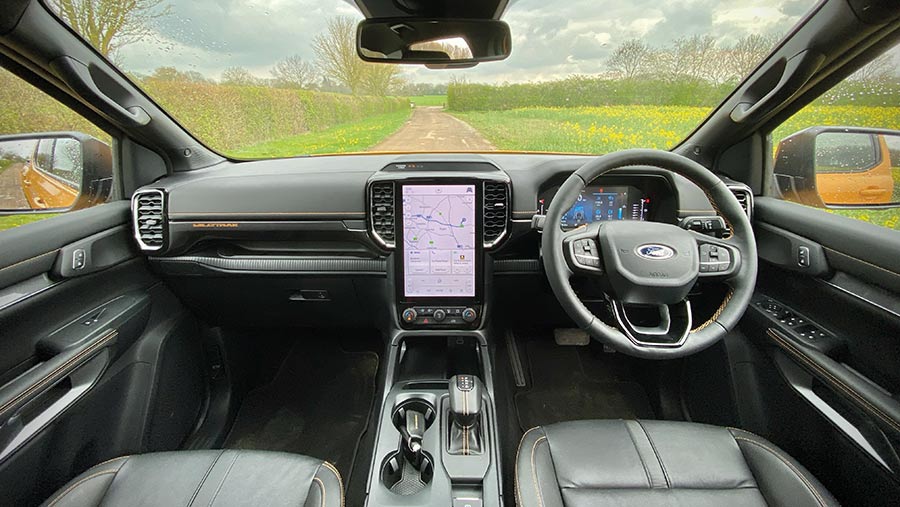First impressions: Ford’s new-look Ranger Wildtrak
 © MAG/Oliver Mark
© MAG/Oliver Mark Seldom does a manufacturer enjoy such market dominance as that of Ford, with its Ranger pickups commanding a peerless 57% share of the sector in 2022.
And the turn of the year saw the most popular manufacturer’s most popular model – the Wildtrak – relaunched with a bigger engine, a slick full-time four-wheel drive system, and an SUV-like cabin.
See also: First impressions: Ford’s new V6 Ranger Raptor pickup
The segue from old to new appears to have done nothing to harm sales, with 5,000 vehicles already spoken for this year and the company well on track to hit its 15,000-unit target – despite lengthy lead times for some variants.
It’s no surprise that the longest wait (around nine months) is for the ever-popular, and now V6-powered, Wildtrak – a model that in recent times has accounted for more than 75% of all Rangers on UK roads.
Ford Ranger Wildtrak V6 spec

© MAG/Oliver Mark
- Engine 3-litre V6 turbodiesel
- Power 240hp@3,250rpm
- Torque 600Nm@1,750-2,250rpm
- Transmission 10-speed auto
- Top speed 112mph
- 0-62mph 8.7sec
- Economy 28mpg
- Turning circle 12.9m
- Weight 2,283kg
- Payload 1,067kg
- Towing capacity 3,500kg
- Price From £43,850 ex VAT; 2-litre version is £39,350
Its launch heralds a return to big-bored blocks, which have been off the menu since the departure of the Volkswagen Amarok in 2020.
To Ford’s surprise, and despite a meaty £4,500 price premium, that pent-up demand has seen early sales of the V6 exceed those of the alternative 2-litre bi-turbo block, which is a carryover from the previous generation.
However, the Wildtrak’s eternal staying power will be tested, with a rejig in the seven-strong Ranger line-up shuffling it down the pecking order to a middle spot.
Above it now come the new Wildtrak X and Platinum models, plus the high-performance Raptor that resides in a league of its own.
The lower-spec Tremor – with less fancy stuff but similar off-road ability – should provide farming buyers with more food for thought, too.
Engine options
The new model might be longer, wider and more comfortable than its predecessor, but chief among the raft of highlights is the introduction of the aforementioned 3-litre V6.
With 240hp and 600Nm of torque on tap it makes the 164hp and 360Nm of the Isuzu D-Max – an established farming favourite – look frightfully feeble.
The more economical option, both in up-front and running costs, is the 2-litre EcoBlue bi-turbo version (205hp, 500Nm). It is good for 32mpg, versus the V6’s 28mpg.
The most basic Rangers, the XL and XLT, are propelled by a single turbo, 170hp iteration of that engine, allied to a six-speed manual or auto transmission.
Redesigned four-wheel drive
The Wildtrak breaks into what was once exclusively Amarok territory in offering a full-time four-wheel drive system, only it also comes with a torque multiplying BorgWarner transfer case to provide low-range gears.
This runs through Ford’s slick shifting but occasionally troublesome 10-speed auto transmission and, as well as offering the customary two- and four-wheel drive high-range modes, it has a neat new 4A automatic setting.
With some electronic wizardry, this provides “torque on demand”, varying the drive between the front and rear wheels according to the conditions.
As a result, it can be used for normal on-road driving without the risk of binding the differentials.
Within this system are six suggested modes – normal, eco, tow, slippery, mud and sand.
When selected, these alter settings related to the traction control system, gear shift timing and throttle response. In some cases, they lock the rear differential too.
It’s also possible to limit the number of ratios available, a useful feature for gnarlier off-roading, and a front diff-lock is available on the options list.
We found its tendency to hover in a gear, instead of upshifting at the first opportunity, was a benefit off-road, but less favourable on it.
Other updates worth mentioning include a higher ride height, provided by coil springs at the front and leaf versions at the rear – rather than the fancier position-sensitive Bilstein setup on the Tremor and Wildtrak X – and a Trail Turn Assist feature that brakes the inside wheel to slash the turning radius by up to 25%.

© MAG/Oliver Mark
New look
The boxy exterior and squared-off nose make the latest Wildtrak a closer relative to its US counterparts than ever before.
The similarities are emphasised by the sheer size of the thing, with its wheelbase and track width both increased by 50mm to deliver a better approach angle and more articulation.
Though the chassis is unchanged, the rear suspension dampers have been shifted outboard of the frame to deliver a smoother ride, with small bumps near imperceptible and jitter kept to a minimum even with an empty load bed.
The downside is that it’s a monstrosity to park, not helped by an unremarkable 12.9m turning circle, and drivers will be reliant on the combination of parking sensors and cameras to slot it between a pair of white lines.
Whether they’ll then be able to get out of the door is another question.
Aesthetic changes of note include the American F150’s so-called “C-clamp” LED headlights, a new grille and bolder arches.
The load bed (1.22m wide, 1.56m long) is rated to over a tonne, comes with a moulded plastic bedliner and will now swallow a Euro pallet without it clashing with the wheel.
Among a handful of natty little improvements are a step behind the rear wheel to ease access – something that the near-identical Amarok won’t have – and an integrated ruler and clamp pockets along the edge of the tailgate to form a make-do work bench.
Inside, it’s less pickup and more SUV. The centrepiece is a Tesla-style 12in central touchscreen, which has thinned out a few manual controls.
Pleasingly, some remain, with nobbly dials for quick adjustments of the dual-zone climate control and sound system volume.
The size of the screen allows for maps, media and temperature to be displayed simultaneously, with more details – predominantly the drivetrain settings, steering angle and the like – housed in the digital dash behind the steering wheel.
Storage is smartly arranged and abundant and the front leather seats are comfortable but, on first impressions, those in the rear don’t get quite as much space as is afforded to passengers in the Ssangyong Musso.
Rest of the range
Propping up the gang of seven Rangers are the XL and XLT, powered by a 170hp 2-litre engine paired with a six-speed manual and part-time 4×4 system.
These sell in surprisingly few numbers (totalling no more than 2% of total sales), but now have a reasonable standard spec.
This is the result of mother regulations coming into play in 2024 that necessitate the inclusion of various driver aids such as cruise control and evasive braking.
As a result, they’re not as cheap as they used to be, with double-cab prices starting at £29,800 ex vat.
Above those come the Tremor, a new model that has less chrome and better off-road credentials than the Limited version it replaces, followed by the Wildtrak, Wildtrak X (2-litre only) and Platinum (V6).
Top spot is held by the Raptor, a sports performance vehicle with a sub-700kg payload that means it doesn’t qualify for the commercial vehicle tax break. It costs the fat end of £60k and sells well in Essex. Say no more…
Farmers Weekly verdict
Early impressions suggest Ford has done little to harm a winning formula.
A better four-wheel drive system and the option of a bigger engine are obvious improvements but, with the V6 starting at almost £44k, there is a price to pay for the upgrades.
Farming buyers willing to settle for the 2-litre, 205hp oil burner might be better served looking at the new Tremor, which is based on the more workaday XLT.
It is £5,000 less than a Wildtrak with the same engine, transmission and 4×4 system, and should have ample power for most jobs.
As such, Ford expects it to take a bite out of the Wildtrak’s market share, though deliveries for it and the Wildtrak X aren’t slated to commence until August.
Electric versions of the Ranger are also said to be in the works. The company is investing heavily in EV technology and, in the US, already has a 600hp electric Lightning version of its F150 pickup.
A quick scour of the Intellectual Property Office website reveals Ford filed for the Ranger Lightning trademark last year, so watch this space.
Likes and gripes
✔ Plenty of power
✔ Quality interior
✔ Slick 4×4 system
✘ Bloomin’ big
✘ It’s getting no cheaper
✘ Petty, but the leather stitching had frayed on our 150-mile test model
